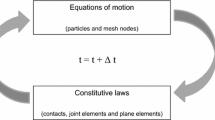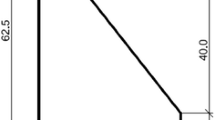Abstract
A numerical model for the hydromechanical analysis of masonry dams based on the discrete element method is presented. The dam and the rock foundation are represented as block assemblies, and a coupled flow-stress analysis is performed in an integrated manner for the entire system. Complex block shapes may be obtained by assembling elementary blocks into macroblocks, allowing the application of the model to situations ranging from equivalent continuum to fully discontinuum analysis. A contact formulation was developed based on an accurate edge–edge approach, incorporating mechanical and hydraulic behavior. The main numerical aspects are described, with an emphasis in the flow analysis explicit algorithm. An application to an existing masonry dam is presented, analyzing its present condition, with excessive seepage, and the proposed rehabilitation intervention. An evaluation of sliding failure mechanisms was also performed, showing the expected improvement in the safety of the structure.












Similar content being viewed by others
References
Barla G, Bonini M, Cammarata G (2004) Stress and seepage analyses for a gravity dam on a jointed granitic rock mass. In: Proceedings of the 1st international UDEC/3DEC symposium: numerical modeling of discrete materials in geotechnical engineering, civil engineering, and earth sciences, Bochum, pp 263–268
Bear J (1988) Dynamics of fluids in porous media. Dover Publications, Inc., New York
Bettzieche V, Deutch R, Heitfuss C (2004) 100 years of experience in ageing of masonry dams and life-time-based rehabilitation. In: 2nd international conference on lifetime oriented design concept—ICOLD 2004, Bochum
Bretas EM (2012) Development of a discrete element model for masonry gravity dams analysis (in Portuguese). PhD Thesis. Engineering School, University of Minho. http://www.civil.uminho.pt/masonry
Bretas EM, Lemos JV, Lourenço PB (2012) Masonry dams: analysis of the historical profiles of Sazilly, Delocre and Rankine. Int J Archit Herit 6(1):19–45
Cammarata G, Fidelibus C, Cravero M, Barla G (2007) The hydro-mechanically coupled response of rock fractures. Rock Mech Rock Eng 40(1):41–61
Casagrande A (1961) First Rankine Lecture: control of seepage through foundations and abutments of dams. Géotechnique XI(3):161–182
Char SA, Mital BK, Chakrabarty NC (1991) Seepage control through masonry dams and foundation of concrete/masonry dams. In: Proceedings of the first conference of research needs in dam safety, New Delhi, vol VII, pp 1–8
Chatterjee KK, Chibber IB, Shenoi RS (1991) Chemistry of underseepage in dam safety tons barrage, India. In: Proceedings of the first conference of research needs in dam safety, New Delhi, vol VII, pp 13–18
EDP (1994) Hydroelectric production center of Ribeira de Nisa—Póvoa Dam: rehabilitation design (in Portuguese). EDP, Porto
Eglinton MS (1987) Concrete and its chemical behavior. Thomas Telford, London
Erban PJ, Gell K (1988) Consideration of the interaction between dam and bedrock in a coupled mechanic-hydraulic FE-program. Rock Mech Rock Eng 21(2):99–117
Gimenes E, Fernández G (2006) Hydromechanical analysis of flow behavior in concrete gravity dam foundations. Can Geotech J 43:244–259
ICOLD (1983) Deterioration of dams and reservoirs—examples and their analysis. ICOLD, Paris
Itasca (2011) Universal Distinct Element Code (UDEC)—version 5.0, Minneapolis
LNEC (2011) Póvoa Dam—inspection of the structure and the monitoring system—November, 2010 (in Portuguese). LNEC, Lisbon
Lombardi G (1985) The role of cohesion in cement grouting of rock (Q 58, R 13). In: 15th congress of large dams. ICOLD, Lausanne, pp 235–261
Lombardi G (1992) The FES rock mass model—part 2: some examples. Dam Eng 3(3):201–221
Louis C (1969) A study of groundwater flow in jointed rock and its influence on the stability of rock masses. PhD Thesis (in Germany), Karlsruhe University, Karlsruhe. Imperial College Rock Mechanics Research, Report No. 10 (English translation), London
Paolina R, Appendino M, Baldovin E, Berra M, Bianchini A, Carabelli E, Posta U, Vielmo I (1991) Deterioration problems for concrete and masonry dams in Italy. In: 17th ICOLD Congress on Large Dams, Vienne, vol Q 65, pp 785–815
Ruggeri G (2004) Uplift pressures under concrete dams, ICOLD European Group
Rutqvist J, Stephansson O (2003) The role of hydromechanical coupling in fractured rock engineering. Hydrogeol J 11(7):7–40
Sauvé RG, Metzger DR (1995) Advances in dynamic relaxation techniques for nonlinear finite element analysis. J Press Vessel Technol 117(2):170–176
Scuero A, Vale J, Vaschetti G, Quintela A, Silva AR, Ramos JM, Costa AS (2007) Rehabilitation of Covão do Ferro masonry dam. In: 5th international conference on dam engineering, Lisbon
Serafim JL (1968) Rock mechanics in engineering practice., Influence of interstitial water on the behaviour of rock massesWiley, London, pp 55–97
Silveira AF, Ramos JM (1994) Strengthening and raising of Lagoa Comprida dam. In: 18th ICOLD Congress on Large Dams, Durban, vol III, Q 70, pp 199–210
Soyeaux R (1990) Seepage flow under dams with jointed rock foundations—a discrete hydraulic model with respect to laminar and turbulent flow. In: Rock joints: proceedings of the international symposium on rock joints, Loen, pp 745–752
Stematiu D (1990) The modeling of water flow through fissure matrix and major joints of a dam foundation rock. In: Rock joints: proceedings of the international symposium on rock joints, Loen, pp 753–758
Wei L, Hudson JA (1988) A hybrid discrete–continuum approach to model hydro-mechanical behaviour of jointed rocks. Eng Geol 49(3–4):317–325
Witherspoon PA, Wang JSY, Iwai K, Gale JE (1980) Validity of cubic law for fluid flow in deformable rock fracture. Water Resour Res 16(6):1016–1024
Wittke W, Wittke M, Kiehl JR (2012) Interaction of a masonry dam and the rock foundation. Geotech Geol Eng 30(3):581–601
Acknowledgments
Permission by EDP to present the example data is gratefully acknowledged. The first author also acknowledges the financial support of the Portuguese Science Foundation (Fundação de Ciência e Tecnologia, FCT), through grant SFRH/BD/43585/2008.
Author information
Authors and Affiliations
Corresponding author
Rights and permissions
About this article
Cite this article
Bretas, E.M., Lemos, J.V. & Lourenço, P.B. Hydromechanical Analysis of Masonry Gravity Dams and their Foundations. Rock Mech Rock Eng 46, 327–339 (2013). https://doi.org/10.1007/s00603-012-0305-3
Received:
Accepted:
Published:
Issue Date:
DOI: https://doi.org/10.1007/s00603-012-0305-3




